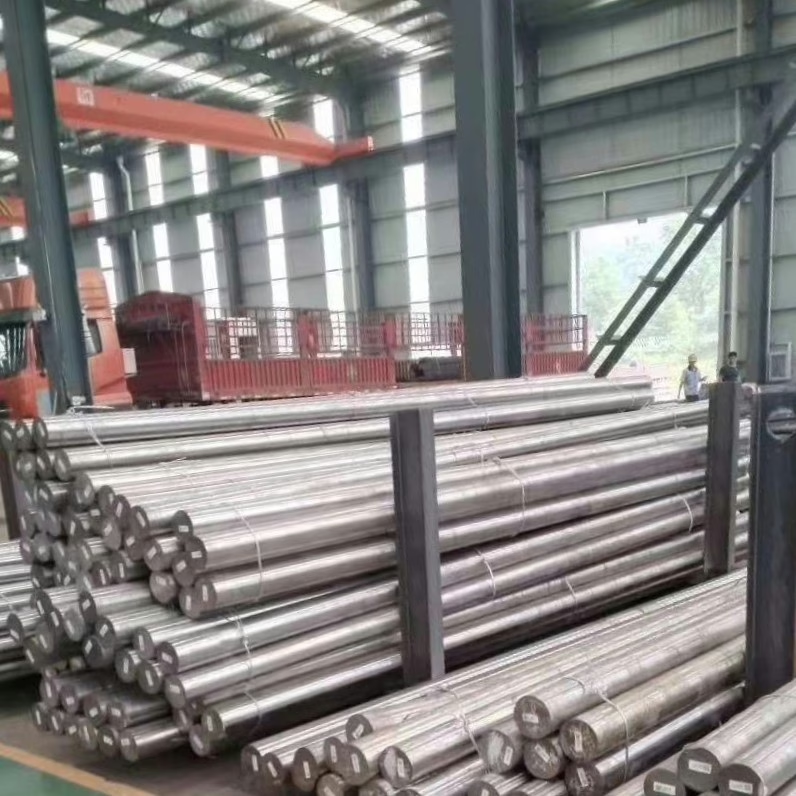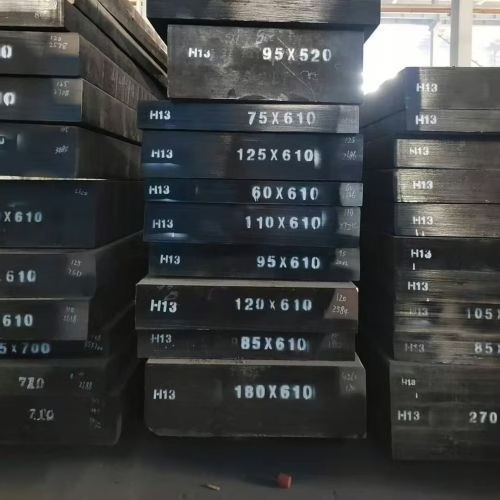
4Cr5MoSiV1 Steel
AOBO STEEL – Trusted Global Tool Steel Supplier
4Cr5MoSiV1 is a hot-work tool steel grade under the Chinese standard GB/T 1299. It is a widely used chromium-molybdenum-vanadium (Cr-Mo-V) hot work tool steel, commonly known internationally by designations such as H13 (AISI/ASTM), SKD61 (JIS), 1.2344(DIN), and X40CrMoV5-1 (ISO/EN/DIN). This steel grade has excellent strength and toughness, good hot workability, and resistance to thermal fatigue.
1. Chemical Composition (GB/ T 1299—2000)
| C | Si | Mn | Cr | Mo | V | P | S |
| 0.32-0.45 | 0.80-1.20 | 0.20-0.50 | 4.75-5.50 | 1.10-1.75 | 0.80-1.20 | ≤0.030 | ≤0.030 |
2. Physical Properties of 4Cr5MoSiV1
2.1 Critical Point Temperatures
| Critical Point | Ac1 | Ac3 | Ar1 | Ar3 | Ms | Mf |
| Temperature /°C | 860 | 915 | 775 | 875 | 340 | 215 |
2.2 Linear Expansion Coefficient
| Temperature/°C | 20 ~ 100 | 20 ~ 200 | 20 ~ 300 | 20 ~ 400 | 20 ~ 500 | 20 ~ 600 | 20 ~ 700 |
| Linear Expansion Coefficient α/×10⁻⁶℃⁻¹ | 9.1 | 10.3 | 11.5 | 12.2 | 12.8 | 13.2 | 13.5 |
2.3 Thermal Conductivity
| Temperature/°C | 250 | 650 |
| Thermal Conductivity λ/[W/(m·K)] | 32.2 | 28.8 |
2.4 Density and Elastic Modulus
| Density/(g/cm³) | Elastic Modulus E/MPa |
| 7.8 | 210 000 |
3. Hot Forging Process Specification of 4Cr5MoSiV1
| Item | Heating Temperature/°C | Initial Forging Temperature/°C | Final Forging Temperature/°C | Cooling Method |
| Steel Ingot | 1140 ~ 1180 | 1100 ~ 1150 | 850 ~ 900 | Slow Cooling (Sand or Pit Cooling) |
| Steel Billet | 1120 ~ 1150 | 1050 ~ 1100 | 850 ~ 900 | Slow Cooling (Sand or Pit Cooling) |



4. Heat Treatment of 4Cr5MoSiV1
4.1 Preheating
Preheating Treatment Process Specification for 4Cr5MoSiV1 Steel
| Pre-heat Treatment Plan | Process Parameters |
| Post-forging Annealing Process | Heating temperature: 860 ~ 890°C, hold for 3 ~ 4h, cool to below 500°C then air cool. Hardness after annealing ≤229HBW, microstructure is globular pearlite + small amount of carbides. |
| Stress Relief Annealing | Heating temperature: 730 ~ 760°C, hold for 3 ~ 4h, furnace cool. |
Hardness and Microstructure of 4Cr5MoSiV1 Steel Before and After Annealing
| Before Annealing | After Annealing | Microstructure (Before Annealing) | Microstructure (After Annealing) | |
| Indentation Diameter/mm | ≈2.75 | ≥3.9 | Sorbite or Martensite | Globular pearlite + small amount of carbides |
| HBW | ≈500 | ≤241 |
4.2 Quenching
Quenching Process Specification for 4Cr5MoSiV1 Steel
| Quenching Temperature/°C | Cooling | Hardness HRC |
| 1020 ~ 1080 | Quenching Coolant | Quenching Coolant Temperature/°C |
| Oil or Air | 20 ~ 60 |
Relationship between Quenching Temperature, Hardness, and Grain Size for 4Cr5MoSiV1 Steel
| Quenching Temperature/°C | 930 | 950 | 980 | 1000 | 1020 | 1040 | 1060 | 1080 | 1100 |
| Hardness HRC | 50.3 | 52 | 53.5 | 54.8 | 56.3 | 57.8 | 58.2 | 59.1 | 59.1 |
| Grain Size/Grade | — | 11.2 | 11.1 | 11.1 | 11.1 | 11 | 10 | 8 | 7 |
3. Tempering
Tempering Process Specification for 4Cr5MoSiV1 Steel
| Purpose | Tempering Temperature/°C | Equipment | Cooling | Tempering Hardness HRC |
| Relieve stress, reduce hardness | 560 ~ 580¹ | Molten salt bath or air furnace | Air cool | 47 ~ 49 |
Note: Usually tempered twice. The second tempering temperature is 20°C lower than the first.
Relationship between Tempering Temperature and Hardness for 4Cr5MoSiV1 Steel
| Tempering Temperature /°C | Hardness HRC | Tempering Temperature /°C | Hardness HRC |
| 100 | 59.0 | 500 | 57.5 |
| 200 | 57.0 | 550 | 53.5 |
| 300 | 54.5 | 600 | 49.5 |
| 400 | 54.5 | 650 | 40.0 |
| 450 | 57.5 | 700 | 30.0 |
4. Surface Strengthening Treatment Process Specifications for 4Cr5MoSiV1 Steel
| Process | Temperature/°C | Time/h | Medium | Diffusion Layer | |
|---|---|---|---|---|---|
| Depth/mm | Microhardness HV | ||||
| Nitriding | 560 | 2 | 50% KNO₃ + 50% NaNO₃ (mass fraction) | 0.04 – 0.07 | 640 – 690 |
| Nitriding | 580 | 8 | Natural Gas + Ammonia | 0.25 | 835 – 860 |
| Nitriding | 530 – 550 | 12 – 20 | Ammonia decomposition rate α is 30% – 60% | 0.12 – 0.20 | 550 – 760 |
5. Mechanical Properties
4Cr5MoSiV1 (H13) steel is an air-hardening hot-work tool steel. It has good toughness and high strength. Because it can be hardened in air, the quenching deformation and residual stress are small, and the tendency for surface oxidation is also small. It can produce a secondary hardening phenomenon, has good thermal stability, and can resist the erosion of molten aluminum alloy. At a working temperature below 650°C, it has high ductility, impact toughness, oxidation resistance, thermal fatigue resistance, as well as high creep strength and tensile strength.
5.1 Longitudinal Mechanical Properties at Room Temperature
| Tempering Temperature/°C | After Quenching | 200 | 400 | 500 | 520 | 550 | 580 | 600 | 650 | 700 |
|---|---|---|---|---|---|---|---|---|---|---|
| Hardness HRC | 56 | 54 | 54 | 55.5 | 54 | 52.5 | 49 | 45.5 | 33 | 28 |
| Tensile Strength Rm/MPa | — | — | 2040 | 2100 | 2080 | 1980 | 1780 | 1650 | 1180 | — |
| Reduction of Area Z (%) | — | — | 40 | 34 | 40 | 48 | 53 | 54 | 55 | — |
| Elongation A (%) | — | — | 11 | 11 | 11.5 | 12 | 12.5 | 14 | 18 | — |
| Impact Toughness ak/(J/cm²) | — | — | 40 | 32 | 35 | 50 | 60 | 70 | 100 | — |
Note: 1020°C oil quenching, tempered 2 times.
5.2 Fatigue Performance of 4Cr5MoSiV1 Steel
| Test Temperature/°C | Room Temperature | 540 |
| σ₋₁/MPa | 730 | 510 |
| σ₋₁ₖ/MPa | 670 | 370 |
5.3 Longitudinal Impact Toughness of 4Cr5MoSiV1 Steel Bar1
| Tempering Temperature/°C | Hardness2 HRC | Charpy V-notch impact absorption energy/J at the following test temperatures | ||||
| -73°C | 21°C | 260°C | 540°C | 595°C | ||
| 524 | 54 | 7 | 14 | 27 | 31 | — |
| 565 | 52 | 7 | 14 | 30 | 34 | 343 |
| 607 | 47 | 8 | 24 | 41 | 45 | 43 |
| 615 | 43 | 9.5 | 24 | 52 | 60 | 57 |
- Air-cooled from 1010°C, and secondary tempered, tempered twice at each specified temperature.
- Room temperature.
- 565°C.
5.4 Longitudinal Tensile Properties of 4Cr5MoSiV1 Steel Bar1
| Room Temp. Hardness HRC | Test Temperature/°C | Tensile Strength Rm/MPa | Lower Yield Strength Rm/MPa | Elongation after Fracture A (%) | Reduction of Area Z (%) |
| 522 | 425 | 1620 | 1240 | 13.7 | 50.6 |
| 540 | 1305 | 1000 | 13.9 | 54 | |
| 595 | 1020 | 825 | 17.5 | 65.4 | |
| 650 | 450 | 340 | 28.9 | 88.9 | |
| 483 | 425 | 1400 | 1150 | 15 | 59.9 |
| 540 | 1160 | 960 | 17.1 | 62.4 | |
| 595 | 940 | 750 | 18 | 68.5 | |
| 650 | 455 | 350 | 33.6 | 89 | |
| 444 | 425 | 1200 | 1005 | 17 | 64.1 |
| 540 | 995 | 820 | 20.6 | 70 | |
| 595 | 827 | 690 | 22.6 | 74 | |
| 650 | 450 | 350 | 28.4 | 87 |
- Quenched at 1010°C (1850°F) in oil, then tempered to the specified hardness.
- Tempered at 527°C for 2 × 2 hours.
- Tempered at 575°C for 2 × 2 hours.
- Tempered at 605°C for 2 × 2 hours.
6. Applications
4Cr5MoSiV1 steel is widely used in the manufacture of hot extrusion dies and mandrels, hammer forging dies, forging press dies, precision forging dies, and die-casting molds for aluminum, copper, magnesium, and their alloys.
Get a Competitive Quote for 4Cr5MoSiV1 Tool Steel
With over 20 years of forging expertise, Aobo Steel is your trusted partner for high-performance 4Cr5MoSiV1 tool steel. We provide not just materials, but solutions. Leverage our deep industry knowledge and reliable supply chain for your project’s success.
✉ Contact us by filling out the form below.
